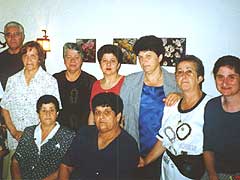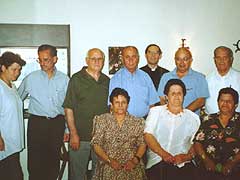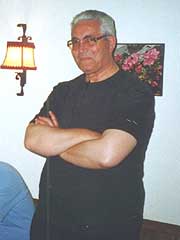 |
| Arab Christians from Nazareth, Haifa,
Kana, and Reneh in Schoenstatt Arabische Christen aus Nazareth, Haifa, Kana und Reneh in Schönstatt |
 |
|
Schoenstatt pilgrims from the Holy Land togehter
with Fr. Grill (top, 3rd from r.) |
 |
|
Fr. Alphonso, Reneh (r): "I'm always thinking of
the shrine!"
Pfr. Alphonso, Reneh (r): "In Gedanken bin in immer beim Heiligtum." |
|
Fotos: Fischer, PressOffice
Schönstatt ©
|
(mkf) Many Christians head for the Holy Land in this Jubilee Year 2000. Eighteen Arab Christians from Nazarethh, Kana, Reneh, and Isfia nea Haifa, came to Schoenstatt July 24 through August 5 to express their love for the Virgin Mary and to strengthen the connection between the Holy Land and Schoenstatt, as one man from Nazareth, visiting in Schoenstatt for the ninth time, shared. Each year, a group of Schoenstatt members and friends from the Holy Land come to Schoenstatt for retreat.
Enaia Younes, Nazareth, was in charge of organizing the program. When asked why she brought the group to Schoenstatt, she responded: "Our Lady chose each of
us to come to Schoenstatt. It is unbelievable that we are here in this Year of Grace. This is a special gift from our Lady of Schoenstatt. Without Nazareth, we would not have Bethlehem, and Kana, and Rome, and Schoenstatt. Schoenstatt helps us to understand what it means to live in Nazareth, to understand the mission."
A man from Nazareth came here for the ninth time. He is the head of the Franciscan Third Order in Nazareth. His wife is head of the Legion of Mary there. He said, "We need to keep in contact with the shrines of the Virgin Mary. We have the grotto in Nazareth, which is the 'Original Shrine' of all Marian shrines. The atmosphere here in Schoenstatt is special. We can pray, we have retreat, we have daily Holy Mass. In Nazareth, we live our daily lives with tensions, problems, and unrest. Here we find the proper atmosphere to pray and to relax. We want to keep in contact with Schoenstatt. The annual visits to Schoenstatt help us to feel affiliated with Schoenstatt."
"Our Lady is From Us!"
Salim, also from Nazareth, came for the first time like ten other fellow pilgrims. He proudly shared. "Our Lady is from us! Therefore, all the Nazareth people feel a relationship with all the places where Mary appeared or works. All are very attractive for us. We want to pray at those places. Here, I feel that Our Lady came to Schoenstatt, erecting her throne here in a special manner, attracting persons from all over the world."
"We came to express our love for Our Lady," another one added. "We love all the places where she is, Fatima, Lourdes, Schoenstatt. She helps us to deepen our faith, she teaches us how to pray."
"I am in Schoenstatt for the first time," said a man. "When I was in Fatima and when I was in Lourdes, I stayed there for one or two days and then left. The atmosphere here is different. I have been here seven days and spent most of the time in prayer. That's amazing."
A woman from Isfia, also in Schoenstatt for the first time, instantly felt attracted to the Blessed Mother when she first entered the Original Shrine. "I never prayed the Schoenstatt prayers before, but I like them. When I go home, I'll share about Schoenstatt!"
They liked Our Lady very much - and now they like her more. That's how several first-time visitors summarized their Schoenstatt experience.
Mission and Message of Schoenstatt
During the days of spiritual retreat, the Schoenstatt pilgrims had an introduction to Schoenstatt by Sr. M. Romelia and visited the Father Kentenich House. Each day, Father Grill, who brought the message of Schoenstatt to the Holy Land, gave a conference on subjects like the covenant of love and the mission of Schoenstatt for the Holy Land.
Daily Holy Mass, confession, and prayer times added to the atmosphere of peace, tranquility and quiet which was much appreciated by the pilgrims.
"I'm impressed with the idea of self-education," said a man. "Here we do not only learn to pray, but also to educate ourselves. Since I have known Schoenstatt I have read the Gospels more often."
"I simply love the shrine," said a woman, "and the calm here, and the sisters. They smile. We cannot communicate verbally, but still ...we feel welcome."
"But it would not be enough to love Our Lady here," said Salim. "We also need to express our love for Our Lady in our everyday life back home. Here we are free, we have the perfect conditions; but we have to express what we experienced here through the way we live. We have to take the atmosphere from here to our homes, to the normal life with all of our troubles. That is the mission of Schoenstatt." – "When I go back home," a woman added, "I want to teach the boys at school to love Our Lady even more!"
Always thinking of the shrine
Father Alphonso of Reneh first came to Schoenstatt in 1998. The visit in 2000 was his second one. "I am still astonished that I never heard about Schoenstatt - a movement that was already founded in 1914. Nobody in our seminary ever told us. I heard about leading a spiritual life, about a Spiritual Daily Order, but I did not know that this came from Schoenstatt. Then I heard about Schoenstatt when I was in Zimbabwe, but I was not interested. Four years ago, I met Enaia and her sister. They convinced me that Schoenstatt is something special. Two years ago I came to Schoenstatt, and I was impressed with the shrine. I have a deep love for this shrine. I pray deeply to Mary there. And I am always thinking of the shrine."
English edition: Joan Biemert, New Franken, WI, USA